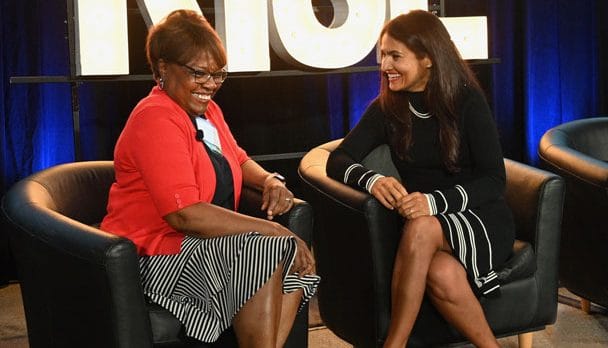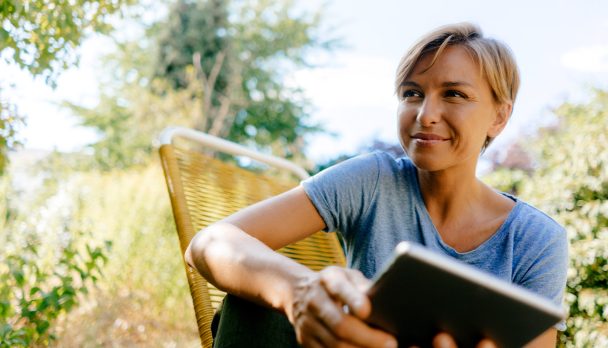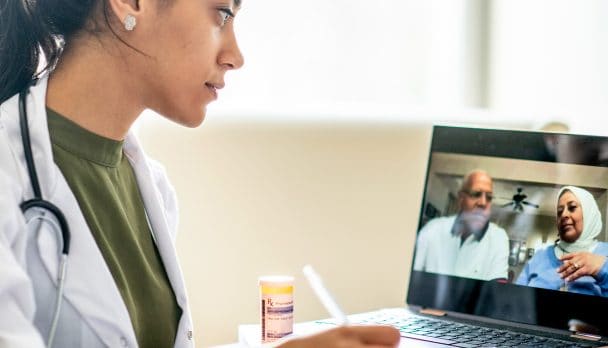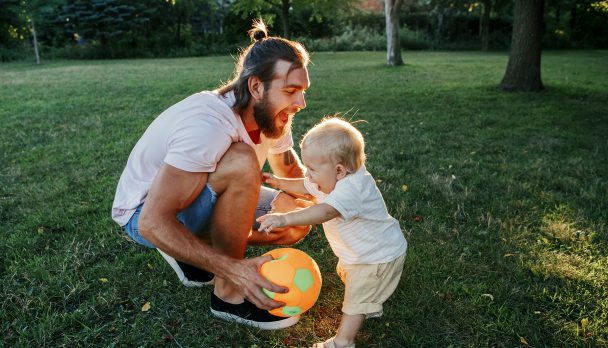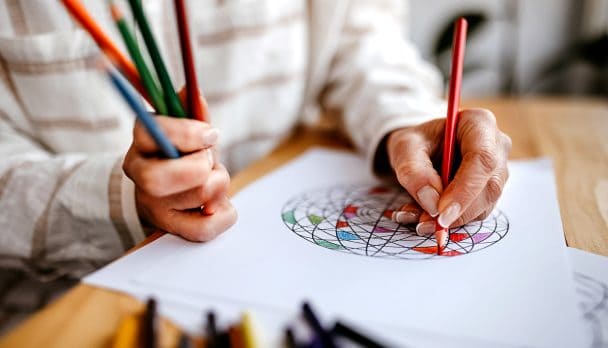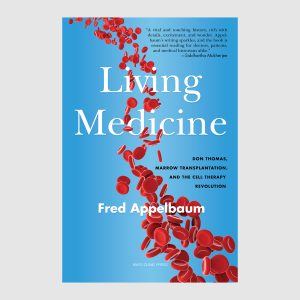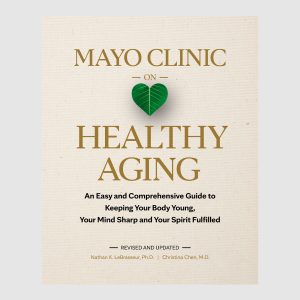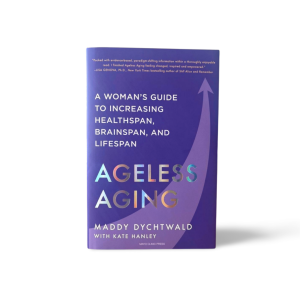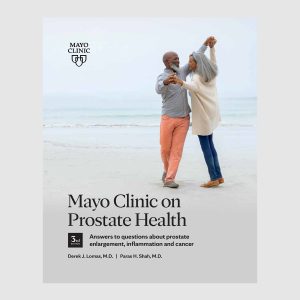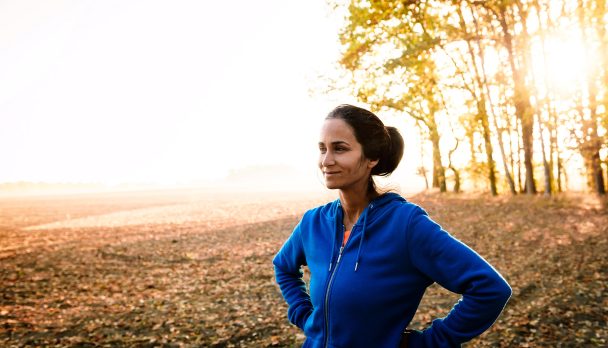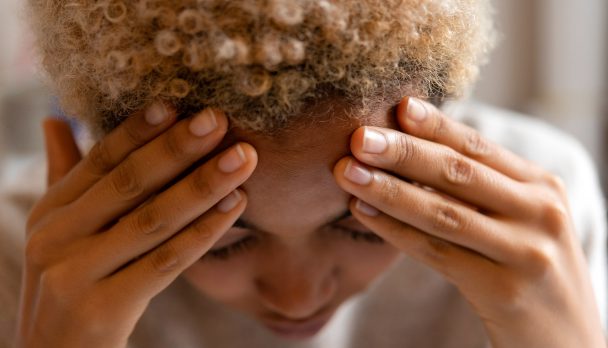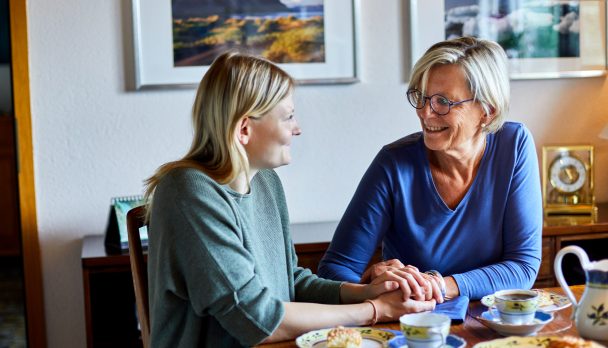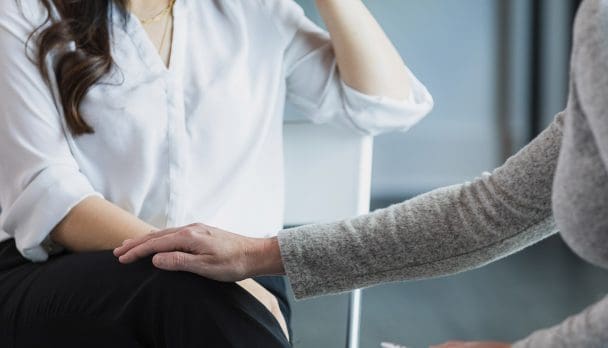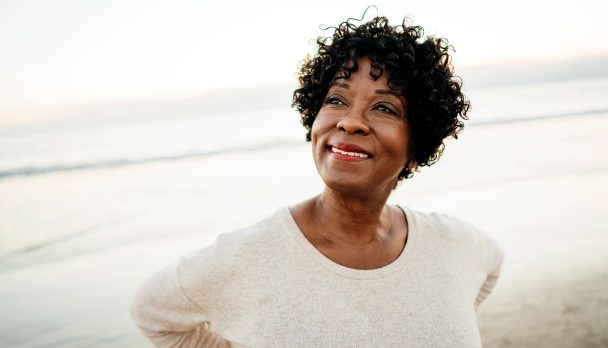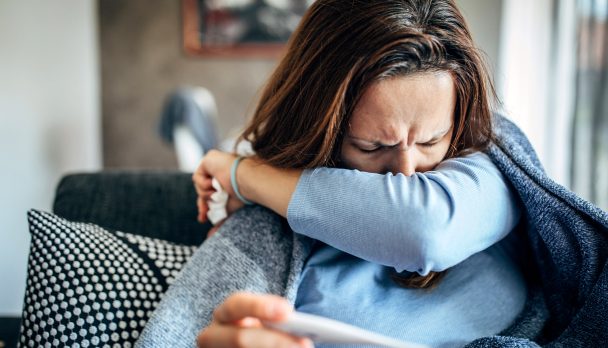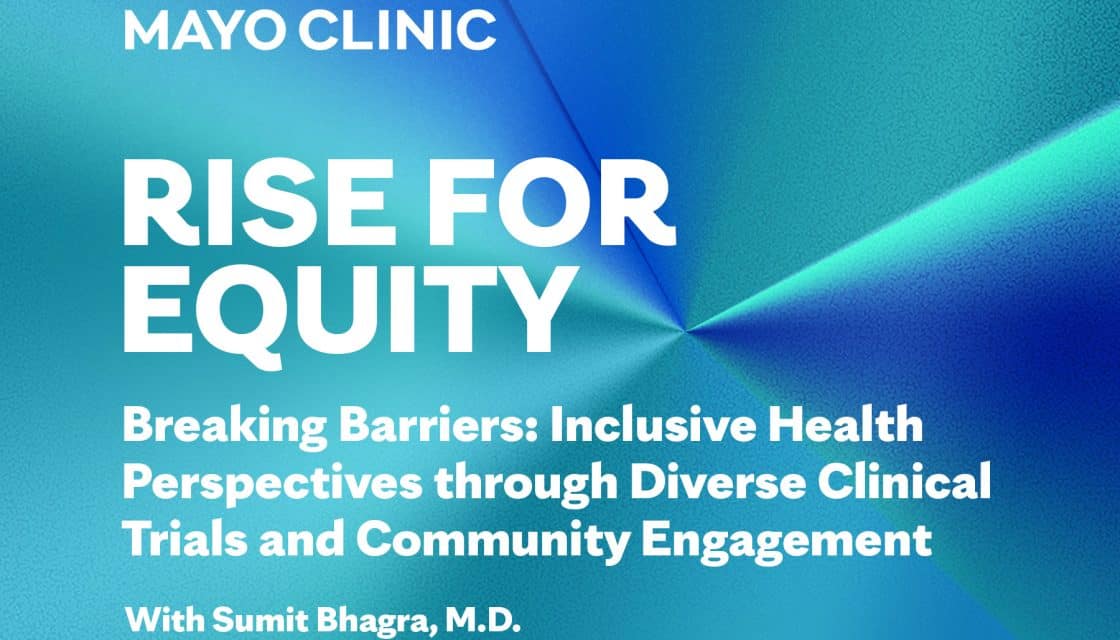
While historically there has been limited inclusion of racial and ethnic minorities in research studies and clinical trials, critical strides have been taken in medicine to increase representation to help address health disparities and inequities. Gaining diverse perspectives in research provides an opportunity to enhance our understanding of the unique challenges faced by different racial and ethnic groups and also helps dismantle biases and stereotypes.
On this episode of the RISE for Equity podcast, Dr. Kim Barbel Johnson and Doug Murrell join host Nicole Nfonoyim-Hara to discuss the impacts of diversifying decentralized clinical trials, and the impacts of community engagement in healthcare.
“Okay, let’s take a carton of eggs, and let’s paint all the eggs a different color. We can say that the carton of eggs are diverse because they’re different colors.But me and you know that the background is the same, the environment is the same, everything else about those eggs are identical except for the color. And so I think when we say diversity, we are meaning so many more things than we have been limited to in our society.”
Douglas Murrell
“We’ve moved from the term decentralized clinical trial generically, and we’ve embraced it as clinical trials without walls because we really want to make sure that this is a culture change.We’ve embraced this, the decentralized aspect of making sure that we understand that clinical trials can be without walls. That is revolutionary for the entire industry. At Mayo Clinic, this has been an ongoing conversation as we’ve seen the need to increase representation and to decrease the barriers for inclusion and clinical trials.”
Dr. Kim Barbel Johnson
Guest:Dr. Kim M. Barbel Johnson is a community-centric, patient-focused Family Physician and Principal Research Investigator working in the Hematology and Oncology departments, at Mayo Clinic, Jacksonville, Florida.
Douglas (Doug) Murrell works with Community Engagement department of Mayo Clinic’s Center for Clinical and Translational Science (CCATS) as the Operations Manager for the Community-Engaged Research Program.
Read the transcript:
Nicole Nfonoyim-Hara:This is a special edition of Mayo Clinic Talks, released in partnership with Mayo Clinic Press. Welcome to the Rise for Equity podcast. In this series, we’ll be talking to leading physicians, scientists, and innovators about what it’s going to take to transform healthcare for a more just, more equitable future.
I’m Nicole Nfonoyim-Hara, your host on the Rise for Equity podcast, and today I’m joined by Dr. Kim Barbel Johnson and Doug Murrell.
Today we’re discussing community engagement in healthcare research, the impacts of diversifying decentralized clinical trials, and the ways in which Dr. Barbel Johnson and Doug continue to advance equity in their own work at Mayo and beyond. Welcome to both of you.
Dr. Kim Barbel Johnson:Thank you so much.
Doug Murrell: Good morning, it’s a pleasure to be with you today.
Nicole Nfonoyim-Hara:So you both work really closely in community engagement and in research, and before we dive more deeply into that, Dr. Barbrel Johnson, could you share with us just a bit more about why you went into medicine?
Dr. Kim Barbel Johnson:I’m a family physician by training, and spent the last year in a dedicated cancer research community, facing trial development. It’s been the most rewarding part of my entire year, but I started this journey pretty much like I am right now very passionate as a West Indian little girl based in St. Thomas in the Caribbean.
I was aware of economic inequities and social inequities in other ways, and in deciding to pursue a career in medicine, I attended Hampton University, went to medical school, came to Mayo for training, I always felt that I had a responsibility to those on whose shoulders I stood and to those who I knew were getting differently, cared for, differently served in medicine.
Having a life of relative privilege in the Caribbean, I knew that it was my responsibility, as my family also thought, to really be our brother’s keepers. That’s what brought me to medicine. That’s what has kept me satisfied in family medicine, and for the last 15 years in clinical trials, recognizing that, where clinical trials are concerned and where advances in medicine are concerned, that the train was really on its way.
The only way that those who were underserved in the space clinically would actually be on par for survivorship, for therapy, for early screening and detection, was for those of us who actually had earned a voice among our communities who were trusted, particularly after COVID, to be more aggressive and involved and intentional about how to do this.
When given the opportunity to return to Mayo and invited to do this in the cancer research space, I jumped at it simply because I knew I would be aligned with incredible people who were also interested and passionate, dedicated and equipped to do that.
Doug and I came on board about the same time and I was proven right when I met Doug, that we were doing this across the enterprise together. So, it’s a pleasure to be able to do this work and honor to be able to do this work.
Nicole Nfonoyim-Hara:And you, Doug?
Doug Murrell:For me, I took a more non traditional route to Mayo Clinic and healthcare in general. I have over 20 years of professional experience serving public-facing organizations that basically are engaging the community for some shared goal or some shared vision. From being a Navy officer, to being an executive pastor of churches, to serving in both large NGO nonprofits, as well as smaller nonprofits, all of them had one thing in common, which was it was a vital part of their mission to engage the communities in which they were a part of the fabric.
I learned both up close and personal, but also from a very strategic standpoint what the commonalities were among that.
The community, I believe, is an essential solution to address that and so to be a part of the work and I mean, hey, if you’re gonna be a part of this work, why not come to Mayo Clinic. I’m so delighted to be a part of what’s happening here and our efforts to not go to the community and not do something for the community, but to partner with them, learn from them and build together. That was an exciting proposition that I could not say no to.
Nicole Nfonoyim-Hara:Thank you both. You demonstrate such a powerful and lifelong commitment in each of your stories to understanding that community, to understanding that people aren’t being cared for in the same way, in a lot of different spaces.
We’re going to be talking a little bit more about what that looks like specifically in your work, but as you know community engagement is such a big term with a lot of meanings. How would you each define community engagement in the healthcare and medical research context?
Doug Murrell:Nicole, a lot of times when we talk about community engagement, particularly in this space, our pictures don’t match and it’s very important for me for our pictures to match, that we’re talking about the same thing. We can all look at an elephant from many different places, and we’re still looking at an elephant, but we describe it very differently.
In the space of healthcare, particularly as it relates to the research, when I think about community engagement, it is our ability to partner with the community in a bidirectional way so that we are addressing community health issues. These are community health issues that the community has identified as priorities and needs within the community and so engaging them specifically for that, so that they are part of the solution, but also give vital feedback to us on that.
From my lens, I think a lot of times we say, okay, anything we do in the community is engaged in the community, and I would say that’s a continue.
We do outreach to the community, but engagement’s a little deeper. It’s a deeper relational connection. Here for us, particularly in the research, that’s important that it is continuous, that it is deep, and that it is sustainable.
Dr. Kim Barbel Johnson:I echo everything that Doug says. As a clinician, I have a slightly different perspective that I do add. All of my life for 25 years, I’ve believed in shared decision-making, whether it was how are you going to treat your diabetes? How are you going to treat your hypertension? Of course, as the expert trained in medicine, I had the how and with what, but I never went home with my patients, at least not often. Unless there were relatives.
I had the opportunity, often 20 times a day, to have shared decision-making conversations. This was not a far stretch from that same concept of engaging with community meant for me, shared decision-making, but with the population in our cohort, in the cancer center catchment area in this particular case.
As Doug said, it’s deeper than outreach. In fact, it involves some inreach as well as outreach. When I was a family physician, treating patients one on one, it involved me being prepared, me being understanding, me being able to check my biases at the door, me preparing myself before I entered into that sacred space to take care of a patient.
It is absolutely no different when I do nine catchment areas in Florida or however many catchment counties in our other areas across the enterprise. It’s the same principle, and I think that that inreach and that outreach for a trusted platform from which to start a conversation where we address those things that need to be addressed, and get some shared decision-making when we address how to move forward to decrease some of the barriers and the burdens of diseases within these communities.
Nicole Nfonoyim-Hara:Thank you. I love that idea of both inreach and outreach and sort of how those two together can really do some powerful work. And Doug the way that you spoke about partnerships and sort of deepening, it’s not outreach, it’s engagement and how to do that in a way that is shared in a way that is about trustboth of you spoke about.
Honestly, community engagement, things like clinical trials have been met with a lot of mistrust, and this mistrust, of course, has a history here in the United States, among our marginalized communities, as well as in global health context. Can you walk us through some of your understanding of the roots of this mistrust in medical research?
Dr. Kim Barbel Johnson:Obviously we talk about the social determinants. We talk about the historic things that have happened in trials. We know now that we have not been the greatest stewards of every community of which we’ve served, and we have not earned the trust of all communities equilaterally, racially, ethnically, in particular, and so now having to go back and rebuild bridges, build bridges to earn that trust is one of the things that we’re now finding ourselves challenged to do.
We first need to take ownership, take responsibility and accountability, and then we need to change the narrative. We need to change the narrative, not by changing the history, but trying to identify those spaces where we have come this far, where we have had those who’ve earned some trust, who have walked alongside those who have been well meaning allies in this space to advance science for all people.
What I feel that we’re now doing is really trying to do both; to address history, but also to excite a community about the things that we have been doing. Then to get that buy-in, to get that understanding so that we can move forward together. I believe that the trust issues are still one of our biggest hurdles, if not the biggest hurdle in this space.
Again we’re not going to get through that space with a single conversation. But it involves a science of trust building, the science of understanding human behavior, and just a personal commitment to wanting to do better so that we all move forward. I think Doug shares some of that, but probably adds a different perspective as well.
Doug Murrell:I think the challenge for me is that we want to engage communities as if there’s no mistrust or if there’s no history. I think you have to acknowledge the elephant in the room. Before we go and talk about all the great things that we’re going to build together, we have to repair the cracks in the foundation.
The cracks in the foundation are very important. That’s the mistrust. How do we do that? It takes time. Any relationship, even in our personal relationships, if there is a mistrust or lack of trust, it takes time to repair that. I think, particularly in our world today, we want to speed past that.
It’s very important that we take that time, that we show up even when we are not looking to get any, that we begin to look at our relationships with the community as not being transactional, but being transformative for the community health. The way that we begin to do that is to spend time.
We begin to try to identify what’s important to the community. I’m finding this, even in research in our role, even when there’s things that we don’t necessarily do, if there are people that we can connect the community to teams within Mayo that are doing those things, we can make the warm handoff.
That’s relational. We do that for each other. “Hey, I know someone that does that. I can make that introduction for you.” We need to do that same thing with the community. When we do that, those are the types of things that build trust. When they see our face in the crowd and they begin to know our face, they will eventually turn to us one day and say, “Hey, don’t you work for Mayo Clinic? Can we talk to you about X?”
That’s sometimes the door that you need to begin to build again. But to try to build a cathedral on a foundation that is falling apart I think is just foolish. I think if we can approach it in a better manner with a little more intentionality about the way we’re building that relationship, I think organic things can happen with the relationship.
Dr. Kim Barbel Johnson:We must continue to have these conversations, but it cannot be a quid pro pro kind of relationship all the time; that I ask you a question, here’s what we identify and here’s the very linear way of moving through this path.
It’s more contextual. It’s more gritty than that. Like Doug says, we have to sit in these spaces and we have to live in these spaces. Sometimes it’s in the silence, not even in the questioning, not even in the answering. We have to just sit in these spaces and, and, and understand even for ourselves, maybe bring some of the conversation, bring some of the answers and get some feedback on those things, because sometimes you don’t know what you don’t know.
I really love that we continue to talk about going into communities, asking communities, coming back and partnering with communities as if it’s like an A to B, to C connection, but I know that those of us who are gathered in this space right now understand it is so not linear, and it is so more complicated and so much more dimensional than that.
Nicole Nfonoyim-Hara:Thank you for that, both of your perspectives on that, this idea of responsibility and the stewardship that you then have to take that information and the questions and the voices and do something about that, as well as this really important perspective that we are all parts of communities.
You are parts of communities. You have your roles at Mayo Clinic and in other spaces, and then you have your role in the community as well. And the work that that role does in building relationship and the importance of that, and the messiness, I think sometimes, again, I think we look on paper and I’m sure you both have to fill out things for all of your projects around outcomes and measures andeverything is on a grid somewhere.
But we know that in reality, that’s not how that actually works, and that it’s messy and there’s vulnerability involved and comfort and discomfort in being in spaces and continuing to ask, like you said, Dr. Barbel Johnson, and that asking is important and continuing to ask from that basis of trust, because as we know, representation matters and beyond that voices matter.
I want to move to talking a little bit about specifically some of that work around diversifying clinical trials and how you work with community engagement around that.
To start we know that clinical trials are often a part of medical research and clinical trial is a term that many may be familiar with, but we’ve also been hearing a lot more about decentralized clinical trials or DCT. Can you talk a little bit about what that is and how that differs from traditional clinical trials?
Dr. Kim Barbel Johnson:It’s one of the most exciting things that have been on my metric in terms of the work that I’ve been able to do and be accountable for as a director for community clinical trials administration here at the Florida campus at Mayo Clinic, we’ve moved from the term decentralized clinical trial generically, and we’ve embraced it as clinical trials without walls because we really want to make sure that this is a culture change.
We’ve embraced this, the decentralized aspect of making sure that we understand that clinical trialscan be without walls. That is revolutionary for the entire industry. At Mayo Clinic, this has been an ongoing conversation as we’ve seen the need to increase representation and to decrease the barriers for inclusion and clinical trials.
The clinical trial space is very regimented and filled with lots of regulations. In a way that still honors all of the things that we tell our patients, “trust us because we have oversight trust us because there are all these checks and balances in place.”
We can do that now outside of the walls of say a Mayo Clinic. We can do that by taking the informed consent process through telephonic channels to explain to patients what the trials are, and to give them opportunities to enroll in trials.
Once that happens, we have opportunities now that we can take processes that are important for clinical trials, such as laboratory and by specimen collection, where we have opportunities and partnerships with brick and mortar spaces and communities across the country where we can have orders that are sent there, but the information is sent back to Mayo in a regulated way, or that we can have people come into the homes so the where with the social barriers may be transportation.
We are using vendors to go into the patient’s home, do the collection according to our protocols so thatyou can participate in trials where that would have ordinarily been a barrier. There are now devices that we can use as we’re using in cancer care without walls and in hospital care. We are introducing more devices so that we can get the quality of the information because we never want to sacrifice safety, efficacy, and quality for convenience.
This concept, as much as it’s a growing concept, it’s a slow and growing concept because we want to do it right, and we want to do it with protected health information, still being protected, the convenience not being the thing that we gain and lose something else. Those are some of the nuances in terms of what this clinical trial without walls space can look like.
Nicole Nfonoyim-Hara:I hear the excitement in your voices, excited, and it’s very palpable. As you’re talking it sounds so expansive. I loved your notes around maintaining the not sacrificing all of the regulations and all of the safety and all of the rigor of a traditional clinical trial in this space and sort of innovating in that space while you’re doing it.
Community really does take on this really sort of expansive new meaning like communities that we often think of as bound by physical or geographical or maybe some other physical aspects are now unbounded in this clinical trials without walls approach.
Dr. Kim Barbel Johnson:I neglected to mention that the clinician, the community being the community of medical partners in this space as well. Beyond just individual patients or populations that may be interested in clinical trials, most people within our community have a medical home somewhere.
So, just imagine being able to foster and facilitate these trials with trusted partners where you can go to your routine clinician’s office and be participating in a clinical trial because of some master service agreement that’s in place because your family physician, internal medicine, physician, gynecologist is part of the collaborating scientists in the clinical trial.
So all of that is part of this clinical trials without wall ecosystem that we’re trying to build. And again, we’re building it slowly because while we know that we can’t be at zero risk, one thing Mayo Clinic is going to be is our best, and so it really involves vetting the right partners. It involves making sure that the culture and the community and the touch points are pretty similar and that we are a good match, that we’re marrying the right partners because we want our Mayo Clinic service to be the same service, the same quality, independent of where that is being collected.
There’s so many nuances where understanding what we talked about earlier, listening, understanding so that we just don’t come up with, “Oh, here’s this great platform. We’ve just centralized.” All of these nuances are important. Understanding who worships on what day, when are those things important?
It’s, what are the centralized processes going to look like with our partners from how they present physically, what car they drive to the protocols in which they engage with the patient for the scientific aspect of the clinical trial. Again, to such a rich, in the weeds kind of space, but I love living in the weeds because I get to understand exactly what this would look like and what success would ultimately look like for the patient.
Nicole Nfonoyim-Hara:In the weeds is often where transformation happens. So much of what you are talking about, too, is really understanding, It’s in the weeds because it’s such a detailed, nuanced level, as you said, around cultural and social and interpersonal personal relationships.
From both of your perspectives, what is a transformational sort of perspective around what it means to diversify for both the clinician and the research end of it and also for the community? What is the benefit of diversifying for the research? What is the best benefit of diversifying for the community?
Doug Murrell:I’ll jump in on this one. I agree. When I was an undergrad many, many years ago, when people would talk about diversity, the example I will always use is I would go, “Okay, let’s take a carton of eggs, and let’s paint all the eggs a different color. We can say that the carton of eggs are diverse because they’re different colors.
But me and you know that the background is the same, the environment is the same, everything else about those eggs are identical except for the color. And so I think when we say diversity, we are meaning so many more things than we have been limited to in our society. When I think about diversity, particularly in this space, what does that look like, not just from diversity and the communities that we’re working with, the patients that we’re working with, but what does it also look like for the providers to be diverse? What does it look like for the navigators, the nurses? When I, as a person of color, walk into a Mayo Clinic, do I see anybody that looks like me besides someone who may be sitting next to me in the waiting room? Are there the physicians that I see going to be diverse?
That becomes a challenge because we like to check that box off and say, okay, well, yes, we have diversity in these areas, but let’s extend that. When I’m talking to an individual do we have a similar enough background to where they understand without me having to go into an explicit detail, what certain things mean.
Having diversity of course, ethnically and racially is important, but I think it’s also very important for us to have diversity as it relates to background environment understanding. All those things are important. When you look at the many different gaps that we have from a disparity standpoint, I think that we can’t do anything but try to close those gaps because we’re not going to get the diversity we’re looking for if we don’t address those gaps as well.
Everything from screening to preventative care to even our science-based public policy. All of those things factor into a widening gap that we’re seeing in health disparities. If we want to really address the diversity issue we have to be able to address those as well.
Dr. Kim Barbel Johnson:So what Doug says is that it is a work. It’s not even about where Mayo Clinic serves, it’s about the world population. That diversity is just beyond what we can see, but it does involve who’s in the room and who’s in the waiting room, and there has to be some connection there as well. Not because you look like me, but there is often citing the need for us to belong, but in addition to that do we feel valued? Do we feel valued when we’re in these spaces?
Do we value the benefit of having a contribution to the educational construct of the communities in which our patients serve because it’s an enveloping, an equalizing educational opportunity. Now, are we in the business of education? Probably not beyond the school of health sciences, but it is so connected.
That’s where I always stop. I always say, particularly because I am Caribbean and I didn’t grow up with a race. I was West Indian. So I went to Hampton, I had to check a box and I owned that box. However, I do recognize that everything that’s within me is within me.
I serve the community in which I serve, understanding that people come in with their own genetic at mixture and that genetic at mixture may not be what they look like, but I need to understand that that is who they are in order to understand how to move forward with this thing that we do in precision medicine.
So we’ve moved from this population health space, let’s get everybody in the population and yet we’re advancing precision medicine. Well, we can’t get to the preciseness of what works for everyone unless everyone is at the table. That’s a part of this diversity I’m at. Packaging aside, let’s get to where you are and understand that if your genetic at mixture is not represented in the things that I’m assessing, if I’m not thinking about those things, I’m never going to diagnose those things. I’m never going to be able toinclude you. My mentor, big brother in medicine, passed out 10 days ago from a condition called myelofibrosis, which if you look up the demographics of the ethnicities, it’s not something that Black men die from, that they get diagnosed with.
Yet, we have someone who wasn’t packaged like that. Went to Mayo to get diagnosed because at least may have thought about it and that’s how he got the diagnosis, but ultimately died from the complications and because it’s an aggressive disease it is what it is.
But what if we had more diversity in that space to understand how to do induction chemotherapy with the genetic at mixture represented? How to watch our safety measures, kidney function, so that all of the complications from that are monitored with the understanding and the breadth and the scope of diversity of epigenetics and genetics in that space.
That’s kind of what diversity means to me. It’s not just about that. And so, because of Dr. Bill Cody,whose shoulders I will continue to stand on as his mentee, that is why I’m in this space, because we are both brown, but we’re both brown differently. But it’s not about our brownness, it’s not about metrics that the NCI puts to say that you must have 10% of your analytic cases, etcetera, represented.
This is about the end game. This is about our North as a mission of Mayo Clinic, our North in doing right and making sure that we are doing the same thing the same way for all people, and that is where I enter the space and that’s how I consider our success, that we’d be successful in diversity, equity and inclusion.
Nicole Nfonoyim-Hara:Thank you both for those powerful, powerful insights. It’s just amazing. I could just listen to both of you all day. This idea that our identities are so much more than the box or the egg carton, Doug. I mean that they’re, they’re expansive, they’re intersectional, they are about all of the things that make us up genetically, epigenetically, as you said, Dr. Barbel Johnson and all of the social things in our experiences in our lives, and what does that look like in these medical spaces, in the research and just in our lives and in our community, all of those things are part of that ecosystem that you both have so, so deeply and wonderfully described in our time together today.
Is there anything in particular that you want to make sure that we get in front of our listeners ?
Doug Murrell:There’s a couple of things that I would want to mention. One, when we talk about particularly engaging the community for the purpose of research. For me, that primarily shows up in two different ways: community outreach and engagement component of our cancer center, as well as community engaged research, which is a part of our center for clinical and translational science.
There’s two tools that we’re using with researchers that are really beginning to pick up momentum. One is called the community engagement studio, which is just a framework for the researcher to be able to work directly with community members, patients, caregivers, other individuals to get insight from them to either enhance the study design, enhance how it’s implemented or how they release those results back to the community.
You assemble this group of what they call community experts, which are people who have some type of insight around this particular topic, and then you connect them with the researcher. Some people will say it’s more like a focus group. I would say it’s like a focus group on steroids.
And so it’s very significant, but the idea is that it starts this bidirectional conversation between the researcher and the community, which they can continue to build on. Community engagement studios are beginning to pick up. We conducted ten in this last year, and we’ll probably look to do significantly more in 2024.
That’s one program. The other tool is what is called a Citizen Scientist Program. The Citizen ScientistProgram is where you take community members who are interested in volunteering and you run them through training to train them about clinical trials. It’s a ten week training period. Once they complete that, then they can be assigned to individual study teams to provide insight to that researcher around that particular study ongoing.
That’s something that we’re seeing pick up. We just had twelve individuals complete that this quarter, and we’re looking to grow that in the future.
Nicole Nfonoyim-Hara:Thank you so much for sharing those two opportunities and really wonderful projects. Dr. Barbel Johnson, did you have any closing insights you wanted to share?
Dr. Kim Barbel Johnson:I would be remiss if I didn’t say that this is a culture change for the medical community, and Mayo Clinic is in line and we’re so committed. We have our money where our mouths are. We are doing the hard work, but it’s hard work. We have to recognize that it’s hard work.
It also requires, while I said some things are not sequential, in this case some of us may need to go back to the beginning. In this case, some of us may need to go back to those tools that the community outreach and engagement department has prepared, that are online in the clinical trial space to understand the kinds of ways that we want to start thinking about even the way in which we develop language for protocols, the way in which we check ourselves to say, is that extra step necessary? Would I want to be compensated for the time that it takes? I know it’s going to benefit you and benefit science, but what about the families that are waiting with patients?
We’re designing trials that actually are just comprehensive in that space. I just want to again say that this is about community outreach engagement. It is about translational science, but it’s about protocol monitoring review. It’s about disease groups. It’s about all of us who actually want to bring science forward to be inclusive.
And just as I’m passionate about this, I don’t expect my daughter, my son to be passionate, nor my colleagues to have the same passions that I do, but in terms of responsibility to the community, we should have that same North, and while there may be rare diseases on occasions, even in the rare disease space, we must make sure that we check ourselves to make sure that we are being completely comprehensive in how we’re approaching this.
I was married to a pilot and the one thing that I loved was I would hear these stories about aviate, navigate, communicate, aviate, navigate, communicate. We can tell you all the stuff last, but let’s make sure we’re doing the aviation and navigation correctly first.
Also, let’s make sure that even though you’ve been on that plane a million times, every single time you get on the plane, you’re going to check all of your safety equipment because the lives of the passengers that you’re now about to transport and your life is at risk. So let’s do the same thing as consistently as our aviation colleagues, so that we are being consistent, we’re being safe, we’re being equitable, and we’re not taking anything for granted.
It is an ecosystem of clinical trials. And if we build that system, it will be inclusive, it will be diverse by default, and that’s where I hope that Doug and I will have other conversations with you down the road, because now we’ll be talking about other things, because we will normalize that diversity inclusion. It won’t happen tomorrow, but we’re here for the ride, right, Doug?
Doug Murrell:That is correct.
Nicole Nfonoyim-Hara:Wonderful. Thank you so much for joining us today, Dr. Barbel Johnson and Doug. You’ve given us such a dynamic overview of how community engaged research and clinical trials have grown and changed, and really the reparative and restorative work of ensuring that communication and trust are built and rebuilt and all of that, given the long history of discrimination and mistrust that you all discussed and shared with us today, and then understanding that the continued impacts of this history and listening to communities and moving forward to educate, empower, transform is going to take time and it’s going to take deep partnership, it’s going to take what you just spoke about, Dr. Barbel Johnson, all of that comprehensive rigor, the scientific sort of innovation and the cultural change within the medical community. But that seems to be what’s next on the horizon for this work. And we so appreciate your work in this role and all of your insights today and beyond. So thank you both again.
Dr. Kim Barbel Johnson:Thank you for helping us to tell our story to tell the Mayo Clinic story, Nicole. I think that’s the power of community. Our community is that we each bring this incredible passion and excitement and language to this space. So, thank you.
Nicole Nfonoyim-Hara:Oh, my pleasure.
Doug Murrell:Yeah. Thank you so much. It takes a village, and just to know that we’re all working together in this space as the African proverb says if you want to go fast, go alone. If you want to go far, go together. So I’m glad we’re on this journey together.
Dr. Kim Barbel Johnson:Me too.
Nicole Nfonoyim-Hara:That’s all for today’s episode of the Rise for Equity podcast by Mayo Clinic. I’m your host, Nicole Nfonoyim-Hara, and we hope you’ll join us for our next episode. We’ll see you then.
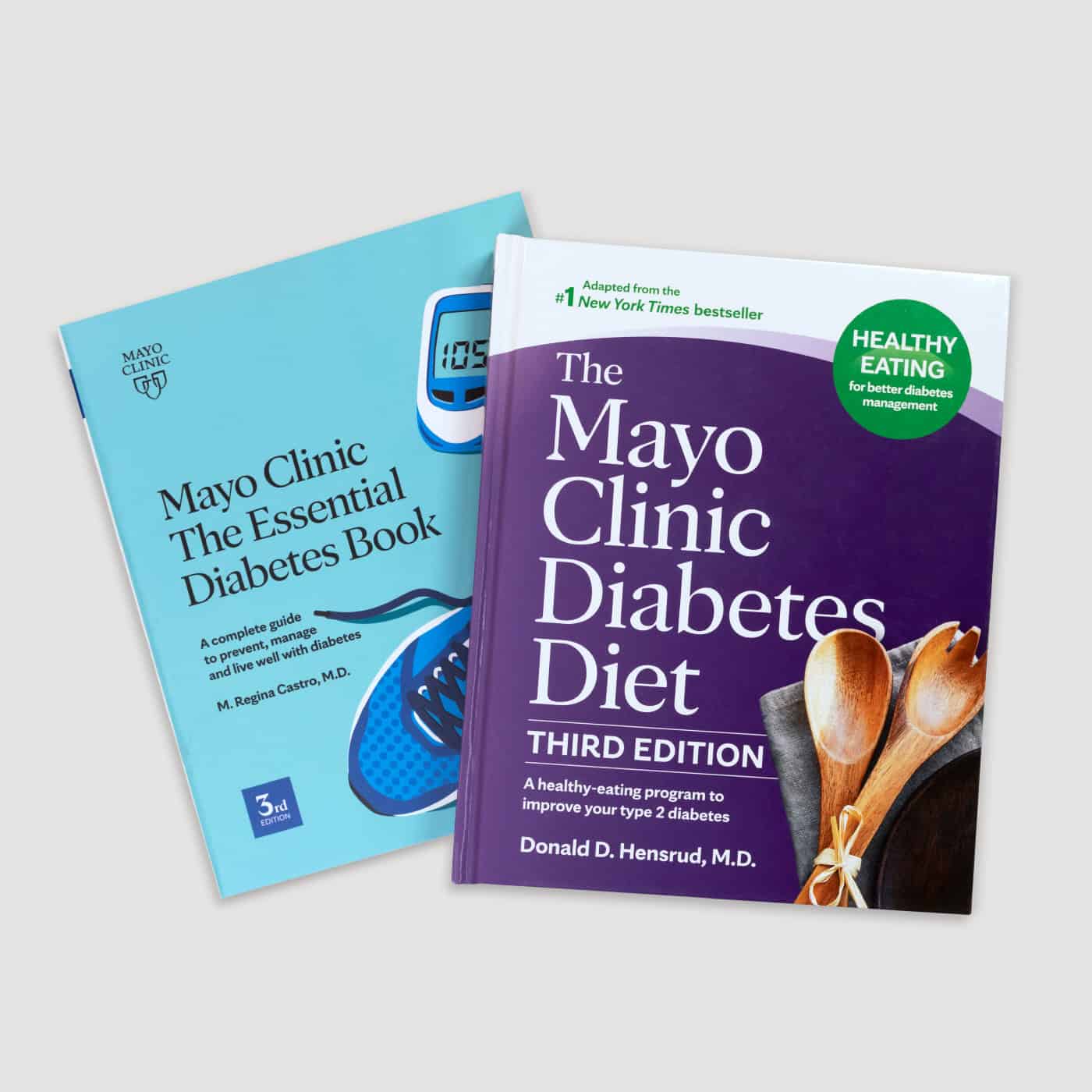
Relevant reading
Essential Diabetes Bundle
The Essential Diabetes Book, 3rd Edition from Mayo Clinic, provides you with key steps to managing diabetes. This includes essential advice on how to monitor your blood sugar, how to eat better, how to become more physically active, how to lose weight and maintain a healthy weight, and how to get…

